Как установить конкретную точку зрения, используя перспективный вид с матрицами
В настоящее время я изучаю теорию 3D-рендеринга с книгой «Обучение современному программированию в 3D-графике» и сейчас застрял в одном из упражнений «Дальнейшее изучение» в обзоре четвертой главы, в частности, в последнем упражнении.
Третий вид деятельности был дан ответ в этот вопрос, Я понял это без проблем. Однако, это последнее задание просит меня сделать все это на этот раз, используя только матрицы.
У меня есть частично работающее решение, но оно кажется мне взломанным и, вероятно, не правильным способом сделать это.
Мое решение третьего вопроса заключалось в колебании трехмерного вектора. EКомпоненты x, y и z по произвольному диапазону создали куб с масштабированием с увеличением (слева направо, в исходной точке OpenGL). Я хотел сделать это снова, используя матрицы, это выглядело так:
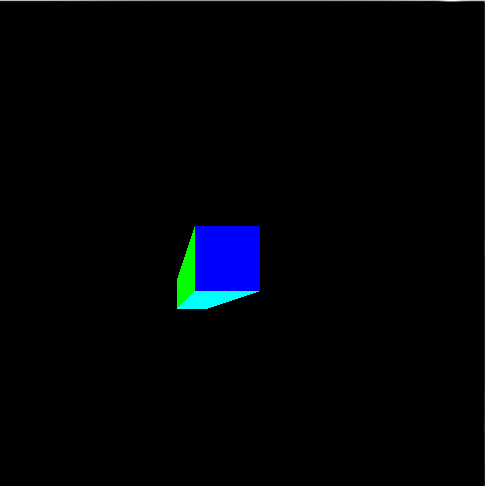
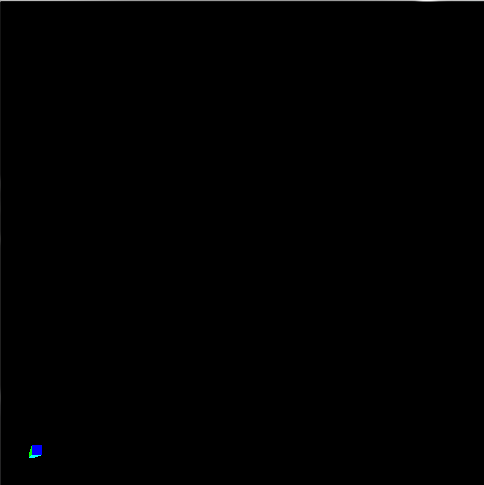
Однако я получаю этот результат с матрицами (игнорируя изменение цвета фона):
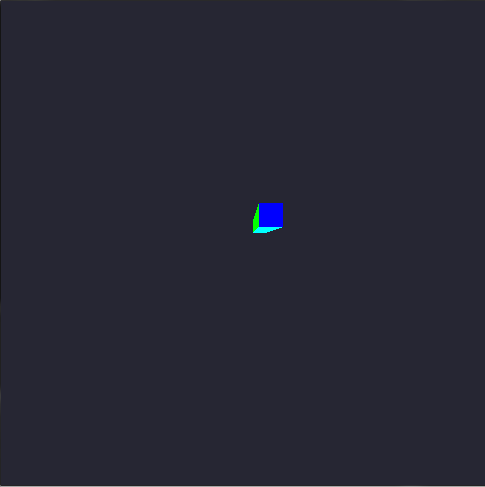
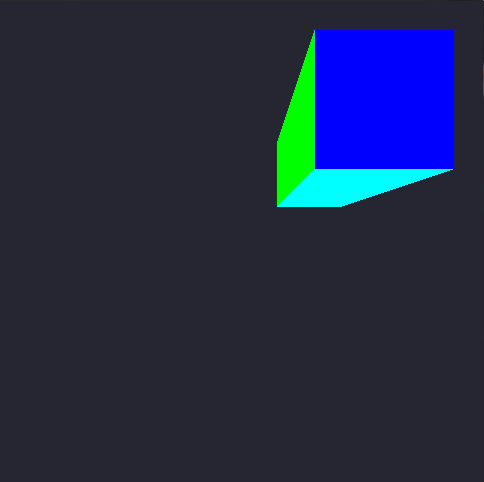
Теперь к коду …
Матрица с плавающей точкой [16] называется theMatrix это представляет матрицу 4×4 с данными, записанными в мажорном столбце со всем, кроме следующих элементов, инициализированных в ноль:
float fFrustumScale = 1.0f; float fzNear = 1.0f; float fzFar = 3.0f;
theMatrix[0] = fFrustumScale;
theMatrix[5] = fFrustumScale;
theMatrix[10] = (fzFar + fzNear) / (fzNear - fzFar);
theMatrix[14] = (2 * fzFar * fzNear) / (fzNear - fzFar);
theMatrix[11] = -1.0f;
тогда остальная часть кода остается такой же, как matrixPerspective учебный урок, пока мы не дойдем до void display()функция:
//Hacked-up variables pretending to be a single vector (E)
float x = 0.0f, y = 0.0f, z = -1.0f;
//variables used for the oscilating zoom-in-out
int counter = 0;
float increment = -0.005f;
int steps = 250;
void display()
{
glClearColor(0.15f, 0.15f, 0.2f, 0.0f);
glClear(GL_COLOR_BUFFER_BIT);
glUseProgram(theProgram);
//Oscillating values
while (counter <= steps)
{
x += increment;
y += increment;
z += increment;
counter++;
if (counter >= steps)
{
counter = 0;
increment *= -1.0f;
}
break;
}
//Introduce the new data to the array before sending as a 4x4 matrix to the shader
theMatrix[0] = -x * -z;
theMatrix[5] = -y * -z;
//Update the matrix with the new values after processing with E
glUniformMatrix4fv(perspectiveMatrixUniform, 1, GL_FALSE, theMatrix);
/*
cube rendering code ommited for simplification
*/
glutSwapBuffers();
glutPostRedisplay();
}
А вот код вершинного шейдера, который использует матрицу:
#version 330
layout(location = 0) in vec4 position;
layout(location = 1) in vec4 color;
smooth out vec4 theColor;
uniform vec2 offset;
uniform mat4 perspectiveMatrix;
void main()
{
vec4 cameraPos = position + vec4(offset.x, offset.y, 0.0, 0.0);
gl_Position = perspectiveMatrix * cameraPos;
theColor = color;
}
Что я делаю не так или что я путаю? Спасибо за время, прочитав все это.
Решение
В OpenGL есть три основных матрицы, о которых вам нужно знать:
-
Модель Matrix D: Отображает вершины из локальной системы координат объекта в мировую систему координат.
-
Посмотреть матрицу V: Отображает вершины из мировой системы координат в систему координат камеры.
-
Проекционная матрица P: Карты (или более подходящие проектов) вершины из пространства камеры на экран.
-
Mutliplied модель и матрица представления дают нам так называемые Модель-вид Матрица М, который отображает вершины из локальных координат объекта в систему координат камеры.

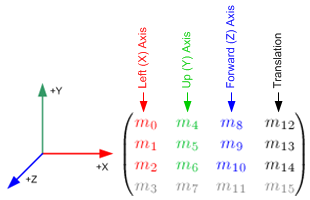
Изменение определенных элементов матрицы вида модели приводит к определенным афинным преобразованиям камеры.
Например, 3 матричных элемента самого правого столбца
 для преобразование перевода. Диагональные элементы
для преобразование перевода. Диагональные элементы  для масштабное преобразование. Изменение соответствующим образом элементов субматрицы
для масштабное преобразование. Изменение соответствующим образом элементов субматрицы 
для преобразования вращения вдоль оси камеры Икс, Y а также Z.
Вышеуказанные преобразования в коде C ++ довольно просты и показаны ниже:
void translate(GLfloat const dx, GLfloat const dy, GLfloat dz, GLfloat *M)
{
M[12] = dx; M[13] = dy; M[14] = dz;
}
void scale(GLfloat const sx, GLfloat sy, GLfloat sz, GLfloat *M)
{
M[0] = sx; M[5] = sy; M[10] = sz;
}
void rotateX(GLfloat const radians, GLfloat *M)
{
M[5] = std::cosf(radians); M[6] = -std::sinf(radians);
M[9] = -M[6]; M[10] = M[5];
}
void rotateY(GLfloat const radians, GLfloat *M)
{
M[0] = std::cosf(radians); M[2] = std::sinf(radians);
M[8] = -M[2]; M[10] = M[0];
}
void rotateZ(GLfloat const radians, GLfloat *M)
{
M[0] = std::cosf(radians); M[1] = std::sinf(radians);
M[4] = -M[1]; M[5] = M[0];
}
Теперь вы должны определить матрицу проекции п.
- Ортографическая проекция:
// These paramaters are lens properties.
// The "near" and "far" create the Depth of Field.
// The "left", "right", "bottom" and "top" represent the rectangle formed
// by the near area, this rectangle will also be the size of the visible area.
GLfloat near = 0.001, far = 100.0;
GLfloat left = 0.0, right = 320.0;
GLfloat bottom = 480.0, top = 0.0;
// First Column
P[0] = 2.0 / (right - left);
P[1] = 0.0;
P[2] = 0.0;
P[3] = 0.0;
// Second Column
P[4] = 0.0;
P[5] = 2.0 / (top - bottom);
P[6] = 0.0;
P[7] = 0.0;
// Third Column
P[8] = 0.0;
P[9] = 0.0;
P[10] = -2.0 / (far - near);
P[11] = 0.0;
// Fourth Column
P[12] = -(right + left) / (right - left);
P[13] = -(top + bottom) / (top - bottom);
P[14] = -(far + near) / (far - near);
P[15] = 1;
- Перспективная проекция:
// These paramaters are about lens properties.
// The "near" and "far" create the Depth of Field.
// The "angleOfView", as the name suggests, is the angle of view.
// The "aspectRatio" is the cool thing about this matrix. OpenGL doesn't
// has any information about the screen you are rendering for. So the
// results could seem stretched. But this variable puts the thing into the
// right path. The aspect ratio is your device screen (or desired area) width
// divided by its height. This will give you a number < 1.0 the the area
// has more vertical space and a number > 1.0 is the area has more horizontal
// space. Aspect Ratio of 1.0 represents a square area.
GLfloat near = 0.001;
GLfloat far = 100.0;
GLfloat angleOfView = 0.25 * 3.1415;
GLfloat aspectRatio = 0.75;
// Some calculus before the formula.
GLfloat size = near * std::tanf(0.5 * angleOfView);
GLfloat left = -size
GLfloat right = size;
GLfloat bottom = -size / aspectRatio;
GLfloat top = size / aspectRatio;
// First Column
P[0] = 2.0 * near / (right - left);
P[1] = 0.0;
P[2] = 0.0;
P[3] = 0.0;
// Second Column
P[4] = 0.0;
P[5] = 2.0 * near / (top - bottom);
P[6] = 0.0;
P[7] = 0.0;
// Third Column
P[8] = (right + left) / (right - left);
P[9] = (top + bottom) / (top - bottom);
P[10] = -(far + near) / (far - near);
P[11] = -1.0;
// Fourth Column
P[12] = 0.0;
P[13] = 0.0;
P[14] = -(2.0 * far * near) / (far - near);
P[15] = 0.0;
Тогда ваш шейдер станет:
#version 330
layout(location = 0) in vec4 position;
layout(location = 1) in vec4 color;
smooth out vec4 theColor;
uniform mat4 modelViewMatrix;
uniform mat4 projectionMatrix;
void main()
{
gl_Position = projectionMatrix * modelViewMatrix * position;
theColor = color;
}
Список используемой литературы:
http://blog.db-in.com/cameras-on-opengl-es-2-x/
http://www.songho.ca/opengl/gl_transform.html
Другие решения
